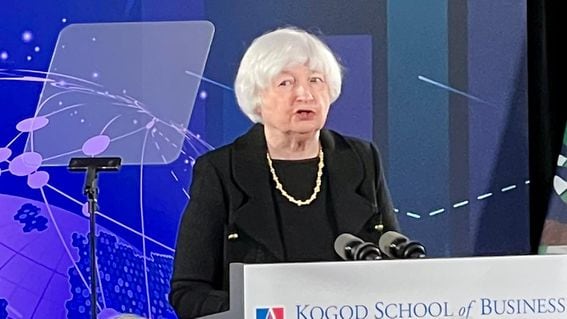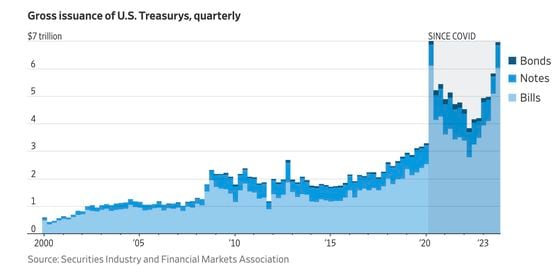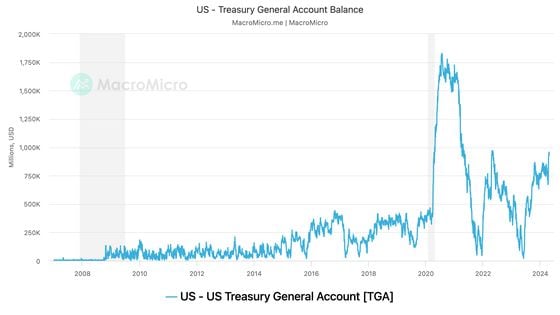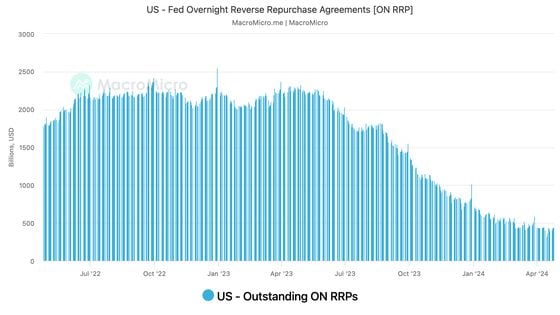

10 Years of Decentralizing the Future
May 29-31, 2024 – Austin, TexasThe biggest and most established global hub for everything crypto, blockchain and Web3.Register Now
- U.S. Treasury’s refinancing announcement, detailing the three-month borrowing needs and the balance to be held in the Treasury General Account, is due on May 1.
- The gross issuance of bonds is likely to decline for the first in two years, offering relief to markets.
- Risk assets will likely rally if the TGA target is maintained at or lowered from the current $750 billion.
The past few weeks have been quite boring for crypto traders as bitcoin (BTC), the leading cryptocurrency by market value, has been primarily range-bound between $60,000 and $70,000.
The broader uptrend, however, could soon resume as analysts expect next week’s quarterly refinancing announcement (QRA) from the U.S. Treasury Secretary Janet Yellen to offer relief to riskier assets.
The announcement, detailing the three-month borrowing needs of the U.S. government, has become pivotal in the post-coronavirus world of record debt, elevated inflation and interest rates. The announcement also discloses the size and duration of the bond issuance, as well as the balance to be held in the Treasury General Account (TGA).
The debt issuance plan impacts markets through the yield channel. Higher bond issuance or supply pushes down bond prices and lifts yields, the so-called risk-free rate, disincentivizing risk-taking in financial markets. Reduced issuance has the opposite effect.
In its previous announcement dated January 29, the Treasury predicted net borrowing of $202 billion in net marketable debt in the second quarter with a TGA cash balance of $750 billion. That’s down significantly from the first quarter’s net borrowing of $760 billion. Financing needs are typically lower in the second quarter as tax payments fill government coffers.
According to Saxo Bank, the upcoming QRA is likely to offer relief, with quarterly gross issuance set to decline from its peak of $7.2 trillion for the first time in two years.
“Factoring in upcoming bills and coupon redemptions, and the latest Treasury financing estimates, the total gross issuance of U.S. Marketable Treasury securities is projected to decline for the first time since the second quarter of 2022,” Althea Spinozzi, head of fixed income strategy, said in a QRA preview.
“Therefore, the big focus for markets shifts towards announcement concerning the Treasury General Account (TGA) level,” Spinozzi added.

The TGA is the U.S. government’s operating account maintained at the Federal Reserve to collect tax revenue, customs duties, proceeds from the sale of securities, public debt receipts and meet government payments.
The TGA is a liability on the Fed’s balance sheet and must be matched by assets. When the Treasury drains the TGA balance, money moves from the TGA account to bank accounts of individuals and businesses, boosting reserves available with commercial banks. That, in turn, boosts lending, leading to monetary easing in markets and the wider economy. An increase in the TGA balance has the opposite effect.
During the debt ceiling drama of early 2023, the Treasury drained the TGA balance as part of extraordinary measures implemented to keep the government functioning. That kept risk assets, including cryptocurrencies, in a bullish trajectory.
Per Spinozzi, risk assets will likely rally if the QRA maintains the TGA target at $750 billion or lowers it.
“If the TGA is maintained at its current level of $750 billion or lower, it implies no change or the potential release of more funds into the economy, providing a boost to economic activity. This might lead to bullish sentiment in risky assets such as stocks and lower-rated corporate bonds,” Spinozzi noted.
On the other hand, if the debt announcement matches estimates but raises the TGA target, it would mean the government intends to hold more cash. Such an outcome may not bode well for risk assets.

Arthur Hayes, a co-founder and former CEO of crypto exchange BitMEX and the chief investment officer at Maelstrom, who predicted bitcoin’s pre-halving weakness, echoed similar sentiments on X.
Hayes explained that the Treasury may stop issuing long-term Treasuries, draining the TGA balance, currently $1 trillion, or issue more short-term bills, unlocking liquidity through the RRP [reverse repurchase agreement] facility. Yellen could also combine both, leading to a liquidity deluge.
“If any of these three options happen, expect a rally in stonks and, most importantly, a re-acceleration of the #crypto bull market,” .

The outstanding overnight (ON) reverse repurchase agreements represent the excess cash parked with the Federal Reserve. The balance has been drained rapidly since 2022 from over $2 trillion to under $500 billion, according to data source MacroMicro.
Edited by Parikshit Mishra.

